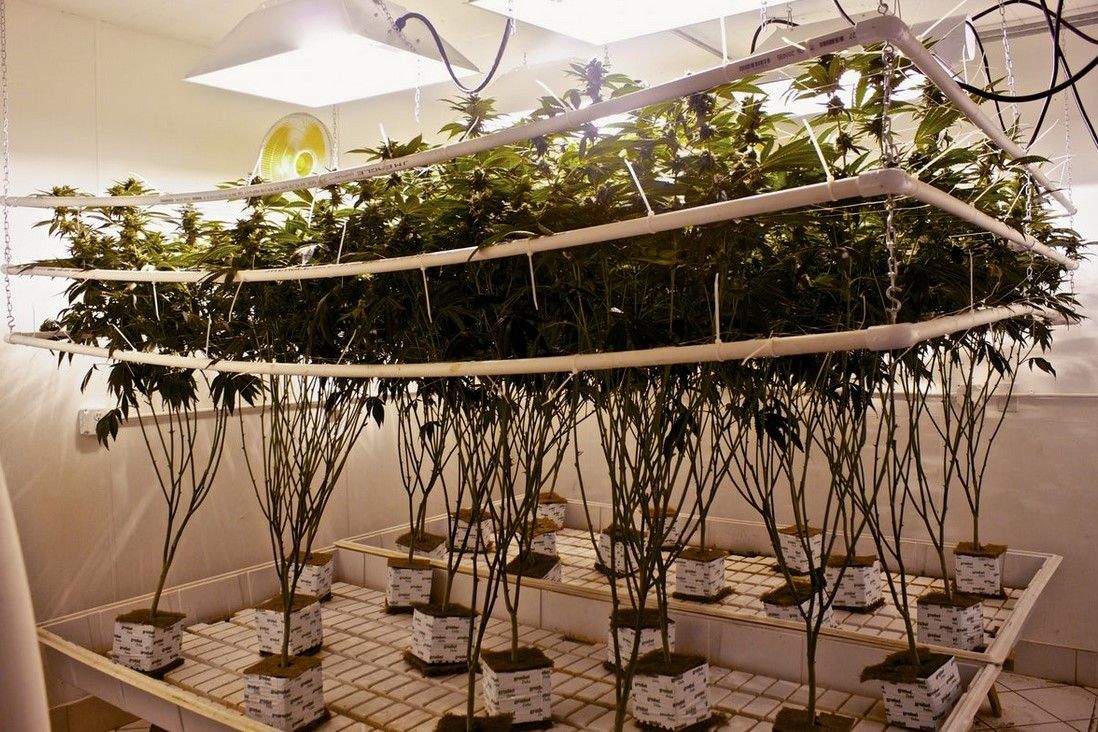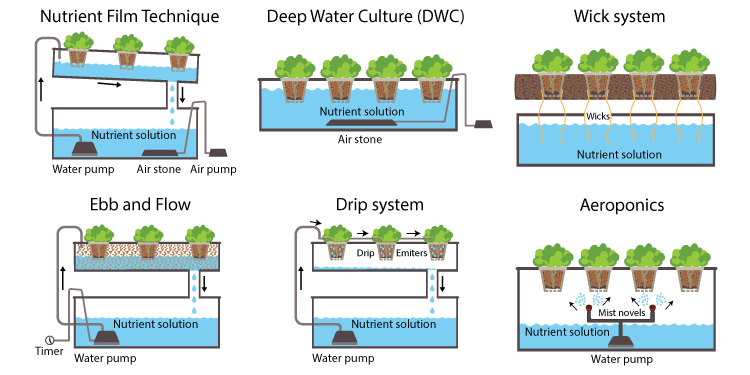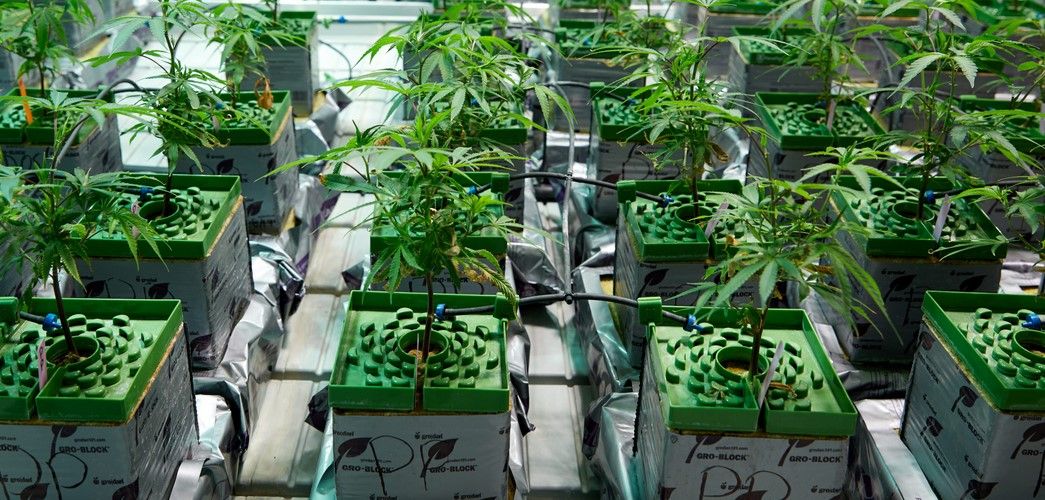Hydroponics is a method of growing plants in water that doesn’t include soil. It refers to the practice of growing cannabis in highly oxygenated water enriched with extra nutrients. In a nutshell, hydroponic marijuana is cannabis cultivated without dirt. You can suspend your plants’ roots in Rockwox, clay pellets, water, coco peat, sand, or gravel to grow them hydroponically.
Regardless of what you use as a growing medium instead of soil, the roots require a nutrient-rich solution to be applied. The water that isn’t absorbed by the roots is reabsorbed through the system for later absorption.
What Is Cannabis Hydroponics ?
A hydroponic system is a method of growing plants without using soil. In other words, you grow plants utilizing an inert growing medium and nutrient-dense solutions. Previously, it was thought that hydroponic systems were difficult and expensive items manufactured solely for commercial use.
However, with hydroponics, you can actually grow marijuana using something as simple as a few pots containing an inert medium. Of course, you could go for a more complicated option, but it would take significantly longer to set up and maintain.
Compared to the soil method, F growing cannabis hydroponically has become more popular due to its many benefits, especially for indoor growers. When “traditionally” using dirt (or ground), farmers face a number of problems that they wouldn’t have otherwise. These include:
- A constant need to monitor the pH of the soil
- Ascertaining the correct level of nutrients
- There is always a potential problem with pests
- You might not be able to recycle the soil you use
- The quality of your soil directly impacts the size and strength of your final product, so be sure to choose wisely.

Hydroponics Nutrients
If you don’t provide the adequate amount of nutrients to your plants, they will die or have a minuscule yield. But, on the flip side, with a hydroponic system in place, the roots can easily find nutrient and doesn’t expend extra energy trying to locate them.
All hydroponic systems must provide oxygen, water, and a host of nutrients to marijuana plants. Nutrients include:
- Nitrogen
- Phosphorus
- Potassium
- Calcium
- Magnesium
- Sulfur
- Iron
- Chlorine
- Manganese
- Boron
- Zinc
- Copper
The three macronutrients are nitrogen, phosphorus, and potassium. The main nutrients are nitrogen (N), phosphorus (P), and potassium (K). The majority of fertilizers include 15% each of the essential elements; this is known as a 15-15-15 solution. If you grow marijuana at temperatures below 80 degrees Fahrenheit, you’ll need more nitrogen. Other conceivable options include 20-20-20 or 23-19-17.
During growth, potassium levels should be raised to at least 20% of a solution during the flowering process. When fertilizing plants, exercise caution as excessive amounts may kill them while too little might cause them to grow slowly. If your reservoir’s water level drops significantly, add three-day-old tap water. It’s also a good idea to swap out the nutrient solution every two weeks and clean all of your equipment, particularly the pumps and reservoir, with hot water on a regular basis.
Setting up Your Cannabis Hydroponics Growing System
There are a number of hydroponic gardening systems available, and all of them may be used to cultivate cannabis indoors. The overall method for every system entails utilizing a nutrient reservoir. It’s then placed in the space between two growing trays. The inert development medium in your choice, such as sand, gravel, or Rockwool, is kept in this tray.
Cannabis hydroponics is produced by growing the plant in a nutrient-rich solution. The roots emerge from the medium and into the nutrients. A tiny pump with a timer is used to fill the bottom layer with nutrient solution. After an allotted period of time, during which the plants are fed and watered, the pump shuts off, causing the solution to return to the reservoir.
The hanging root structure of cannabis plants enables them to always be exposed to air, resulting in a stronger crop. With dirt, marijuana plants have to expend energy searching for key things they need like air, water, and nutrients. Indoor hydroponics gardening provides an easy way to give the food, water, and oxygen cannabis plants needs so they can focus on growing larger.
Before you choose a hydroponic system, consider what your goal is for the plants you’re growing. There are many types of ‘plug and play’ options that come with everything included so finding one shouldn’t be difficult. However, if you plan to build your own system, here’s a list of essentials:
- One large (3 – 5 gallon) bucket per plant
- A water pump
- An air pump
- A reservoir tank
- An air stone
- A grow table
- A growing medium such as Rockwool or clay pellets
- Plastic tubing
- A drip line and up to two drip line emitters for each plant
There are many different types of indoor hydroponic systems available on the market, but we will only be focusing on the best known ones.
Types of Hydroponic Systems

Deep Water Culture (DWC)
If you’re a beginner grower looking for an easy hydroponic system to use, this is the one for you. All you need to do is put your plants in containers and place them in a grow tray that hangs over your water tank. The air pump oxygenates the water so the roots can breath, and then you just add nutrients to the water to feed them.
Even though the roots are submerged in water, the oxygenated air pumps make sure they receive enough oxygen.
Drip Irrigation
Landscapers often choose this type of irrigation because it conserves water. You should place small droppers by the roots in pots with the growth medium, and they will gradually drip out and be absorbed by the plant. With a low rate of evaporation, you can keep your property secure without raising suspicions.
Aeroponics
With this method, you don’t need a growing medium like most growers do. Most only use a small amount to root their cutting or germinate the seed. For this method, however, the roots of the marijuana plant are suspended in mid-air inside an enclosed chamber that is kept at 100% humidity. You must then use a fine spray filled with nutrients.
With this type of feeding, the roots can absorb more oxygen, resulting in plant growth that is up to 10 times faster than if it were grown in soil. There is much less water loss through evaporation as well. However, you need to be cautious of possible clogged misting valves since they could block moisture from getting to the roots and kill your plants.
Ebb & Flow
Unlike many hydroponics systems, this one doesn’t keep the roots submerged in water constantly. Instead, it functions similarly to an ocean tide; flooding a tray with oxygenated water and then receding back into the reservoir. When you’re ready to flood the garden again, simply turn on the pump.
Nutrient Film Technique (NFT)
The NFT system can be complex, but it’s simply a matter of pumping water from the reservoir to your planting tube. This is usually done with large PVC tubing that’s slightly tilted so that when the water drains down, it passes by the roots of all plants before being recycled back into the container.
One of the primary issues with this system is that water might not flow out of the tube and could instead sit in the channel, killing your plants. To avoid this problem, ensure you cut the tube at a sharp enough angle so water can pass through easily.
Wick System
This is another straightforward method. It functions similarly to a DWC system in that it makes use of a substance like rope through a PVC tube. You pull the solution up the line and set it in the tray. Because you don’t have to bring water to the plants with this wick method, you won’t see any difference between it and more complicated systems. However, practicing using this technique is perfect for learning hydroponics.
What Are the Most Common Hydroponics Growing Mediums?
Five of the growing media available on the market are notable. Please keep in mind that each choice has a different capability to retain water and allow oxygen to enter.
Clay Pellets
Although they are light enough to work with efficiently, clay pellets are still sturdy enough to support marijuana plants. They wick moisture up to the roots due to their size and enable oxygen flow through easily.
Rockwool
The popularity of this medium stems from its moisture retention abilities. It’s made out of tiny rock fibers that have been spun at haut speeds using extremely high temperatures. If you want to use Rockwool as a hydroponic growing medium, soak it in a solution with a pH of 5.5 for up to 12 hours. Make sure the pH is between 5.5 and 6 before usage
Coconut Fiber
This is a more environmentally-friendly option than Rockwool because coconut fibers come from waste products. As well as Coconut fiber alsofunction to control humidity and disease.
Perlite
White perlite is a porous, white substance that effectively retains and wicks moisture. In general, you should buy huge chunks rather than tiny granules. Each perlite particle has hundreds of tiny holes on its surface. A large surface area with nutrients and moisture retained promotes growth. It’s a sterile substance, so there’s no risk of pests, rodents, or illnesses.
Vermiculite
This volcanic rock is similar to perlite and drains water well. Although it doesn’t contain harmful bacteria, vermiculite isn’t typically used as a standalone growing medium – growers usually mix it with perlite. If you’re considering using it, ask the seller where they got it from. For example, African sellers might have vermiculite that’s alkaline with a pH up to 9.0.
While hydroponics has many advantages, there are more than a few downsides. Let’s explore both sides of the coin next.

The Pros & Cons of Hydroponics
Pros
- It enables for better yields from smaller development areas.
- Almost total control over the growing process, which typically means better quality cannabis.
- With hydroponics, weed matures quicker, and therefore farmers can harvest six crops annually.
- Without soil, you won’t have to stressing over different types of pests, which in turn means no pesticides will be necessary.
- By monitoring your progress closely, you can reduce the chances of water stress for your crops.
- With complete control, you can personalize feeding schedules to the requirements of a certain plant.
Cons
- A top-tier hydroponic system won’t come cheap; if you’re only a casual grower, it’s probably not worth your money.
- While lowering your risk of disease, water-borne plant diseases present a distinct danger. They spread rapidly and are tough to eradicate.
- It’s a difficult procedure that needs expertise and patience, except the Wick and DWC systems.
Tips for Growing Your Cannabis Hydroponicі
When Hydroponically growing cannabis plants, there are many things to take into account as it is entirely different from indoor methods.
Sterile Equipment
It’s difficult to convey how crucial it is to start with clean equipment. To avoid bacteria growing and spreading, all tanks, reservoirs, filters, pipes, and other equipment must be sterile. Although hydroponic systems are less prone to illnesses than soil-based systems, if left unchecked they will quickly spread. It is a good concept to keep several bottles of hydrogen peroxide and isopropyl alcohol on hand for disinfection of your equipment.
Water pH
You should always circulate pH-neutral water (at 7.0) through your hydroponics system. One way to generate and provide this type of water is by reverse osmosis (RO), but you can also purchase distilled water temporarily until you have the RO system set up.
Temperature Considerations
It is ideal if the water in your system runs at a temperature of 65 degrees Fahrenheit. This is the best temperature for nutrient absorption, as well as preventing algae blooms. Begin with keeping your growing area’s temperature at 75 degrees Fahrenheit.
Humidity
Maintaining the right humidity levels when growing cannabis indoors is a difficult, but crucial task. You have to start with high humidity and gradually lower it as your plants grow. When your seedlings are in the vegetative state, keep the moisture around 60-70%. Then, reduce it by 5% every week until it gets down to approximately 40% during the blooming stage. Most likely, you will need to buy both a humidifier and dehumidifier in order reach these targets efficiently.
Lighting
There is no such thing as the “right” lighting arrangement; instead, there is the ideal one for your grow area and budget. You can buy High-Intensity Discharge (HID) lights, for example, if you have a big space with excellent ventilation and airflow.
If you don’t have a lot of space, consider LED lights or Compact Fluorescent Lights (CFLs) on a smaller budget. Overall, select lighting that emits light within the range 400 and 700 nanometers.
Airflow
Air flow is essential for keeping your growing room at the correct temperature. Purchase a few fans and position them in your cultivation area according to need.
Keep Records
It’s critical to keep track of your crop’s development, no matter how experienced you are or if this is your first time growing marijuana. Novices frequently have spectacular success only to find out they haven’t kept any records. pH levels, planting dates, EC readings, temperature, and humidity are all crucial information.
Growing hydroponic cannabis is a fascinating alternative, with several possibilities. There are, however, hindrances to overcome.
Final Thoughts on Hydroponic Marijuana
There’s a lot to like about hydroponic cannabis. It allows you to produce a lot more each year, and all you need is a little growing space. In areas where you can’t grow in soil, it allows you to develop high-quality cannabis. There are fewer insects, and well-grown hydroponic marijuana has an excellent level of quality.
Growing cannabis is not an easy task, and the initial set-up costs are significant. If you aren’t able to keep the grow area clean, your entire crop could be destroyed by diseases very quickly. It takes more than just a day to learn how to do it well, but if you have time and money and are willing to be patient, learning how to grow cannabis in this way could lead to great rewards.
If you’re only growing recreationally, we don’t recommend this method as it’s designed for those harvesting large numbers.

